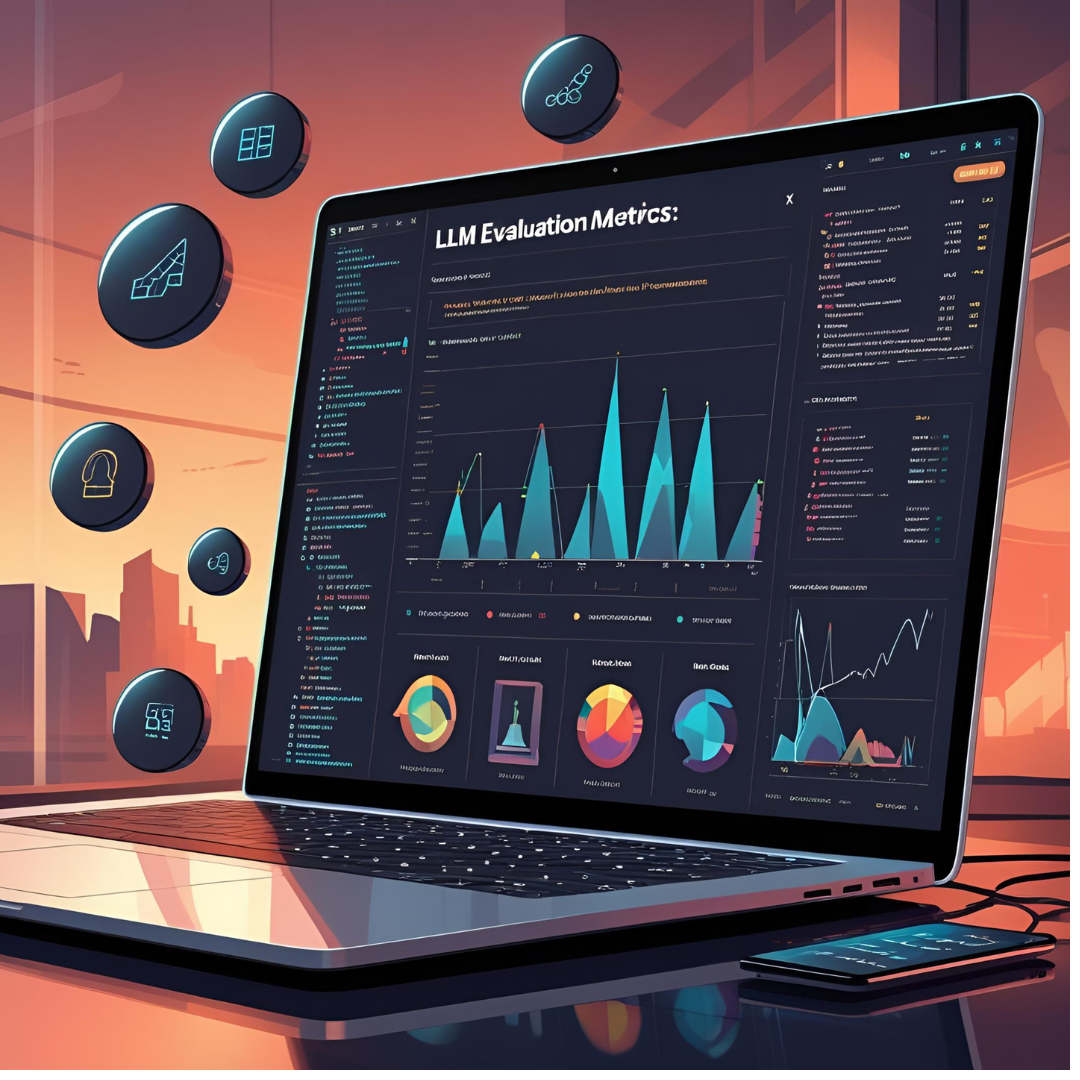Evaluating Large Language Models presents unique challenges that distinguish it from traditional machine learning assessment. Unlike supervised learning tasks with clear ground truth labels, LLM evaluation must account for the subjective nature of language quality, the diversity of possible correct responses, and the multifaceted aspects of language understanding and generation. This comprehensive guide explores the landscape of LLM evaluation metrics, from automated scoring systems to human assessment frameworks, providing practical insights for measuring model performance across different applications and use cases.
The Complexity of LLM Evaluation
Traditional machine learning evaluation relies heavily on quantitative metrics with objective ground truth – accuracy for classification, RMSE for regression, or F1 scores for information retrieval tasks. LLM evaluation, however, must grapple with the inherent subjectivity and creativity of human language. A single query might have multiple equally valid responses, each with different strengths in terms of accuracy, helpfulness, creativity, or style.
The multidimensional nature of language quality adds further complexity. A response might be factually accurate but poorly written, or creatively engaging but factually questionable. Different applications prioritize different aspects – a customer service chatbot values accuracy and helpfulness over creativity, while a creative writing assistant might prioritize originality and engagement over strict factual adherence.
Context dependency presents another evaluation challenge. The same response might be excellent in one context and inappropriate in another. Cultural nuances, domain expertise requirements, and user intent all influence what constitutes a high-quality response, making universal evaluation metrics difficult to establish.
Automated Evaluation Metrics
Automated metrics provide scalable, consistent evaluation that enables rapid model comparison and iterative improvement. These metrics range from simple statistical measures to sophisticated neural network-based assessments that attempt to capture human judgment patterns.
BLEU (Bilingual Evaluation Understudy) scores measure n-gram overlap between generated text and reference responses. Originally developed for machine translation, BLEU provides a quantitative assessment of how closely generated text matches expected outputs. However, BLEU’s reliance on exact matching makes it less suitable for open-ended generation tasks where multiple valid responses exist.
ROUGE (Recall-Oriented Understudy for Gisting Evaluation) metrics focus on recall-based evaluation, measuring how much of the reference content appears in the generated text. ROUGE-L considers longest common subsequences, while ROUGE-N examines n-gram overlap. These metrics work well for summarization tasks but may miss semantic equivalence expressed through different vocabulary.
METEOR (Metric for Evaluation of Translation with Explicit ORdering) addresses some BLEU limitations by incorporating synonyms, stemming, and word order considerations. It provides more nuanced assessment by recognizing that different words can convey similar meanings, making it more suitable for diverse generation tasks.
BERTScore leverages contextual embeddings to measure semantic similarity between generated and reference texts. By using pre-trained language models to encode text meaning, BERTScore can recognize semantic equivalence even when surface forms differ significantly. This approach better captures the quality of paraphrases and semantically similar but lexically different responses.
Task-Specific Evaluation Approaches
Different LLM applications require specialized evaluation approaches that align with their specific objectives and success criteria. Question answering systems prioritize factual accuracy and completeness, while creative writing applications focus on originality, engagement, and stylistic quality.
For factual question answering, exact match and F1 scores provide baseline measurements, but these must be supplemented with semantic equivalence detection and fact verification against authoritative sources. Knowledge-intensive tasks benefit from citation accuracy metrics that assess whether generated responses properly reference and utilize provided source materials.
Summarization evaluation combines extractive and abstractive quality measures. Extractive metrics assess how well summaries capture key information from source documents, while abstractive measures evaluate the quality of reformulated content. Coherence, conciseness, and coverage metrics help assess different aspects of summary quality.
Code generation tasks enable more objective evaluation through execution-based metrics. Functional correctness, syntax validity, and performance benchmarks provide concrete measures of code quality. However, these technical metrics should be balanced with assessments of code readability, maintainability, and adherence to best practices.
Conversational AI evaluation must consider multi-turn coherence, context maintenance, and user satisfaction across extended interactions. Single-turn metrics miss important aspects of conversational quality like consistency, personality maintenance, and appropriate context utilization across conversation history.
Human Evaluation Frameworks
Human evaluation remains the gold standard for assessing LLM performance, particularly for subjective qualities that automated metrics struggle to capture. However, human evaluation presents its own challenges including cost, scalability, and consistency across different evaluators.
Structured evaluation frameworks help standardize human assessment and improve reliability. Rating scales for different quality dimensions – such as accuracy, helpfulness, coherence, and appropriateness – provide quantitative measures that can be aggregated and compared across models and applications.
Comparative evaluation methods present evaluators with multiple model outputs for the same input, asking them to rank or choose the best response. This approach often produces more reliable results than absolute scoring, as it’s easier for humans to make relative quality judgments than assign absolute scores.
Expert evaluation brings domain-specific knowledge to the assessment process. For specialized applications like medical question answering or legal document analysis, expert evaluators can assess accuracy and appropriateness in ways that general evaluators cannot. However, expert evaluation is expensive and may not scale to large-scale model comparison studies.
Crowdsourced evaluation platforms like Amazon Mechanical Turk enable large-scale human assessment but require careful quality control measures. Multiple evaluators per task, qualification tests, and agreement thresholds help ensure reliable results while managing costs and timeline constraints.
Bias and Fairness Assessment
Evaluating LLM bias and fairness requires specialized metrics and methodologies that go beyond traditional performance measures. These assessments examine how models perform across different demographic groups, cultural contexts, and sensitive topics.
Demographic bias evaluation tests model performance across different identity groups, measuring whether response quality varies based on perceived user characteristics or content about different communities. This might involve analyzing sentiment, respect, and accuracy of responses related to different demographic groups.
Representation bias assessment examines whether models fairly represent different perspectives and communities in their outputs. This includes analyzing the diversity of examples, case studies, and cultural references used in generated content.
Stereotyping detection involves identifying when models generate content that reinforces harmful stereotypes or makes unfounded assumptions about individuals or groups based on demographic characteristics. Automated detection tools can flag potentially problematic content for human review.
Fairness metrics measure whether models provide equitable service quality across different user groups. This might involve analyzing response length, helpfulness, and accuracy across different demographic categories to identify potential disparities in service quality.
Performance Benchmarking and Standardization
Standardized benchmarks enable systematic comparison across different models and approaches. These benchmarks typically include diverse tasks, evaluation metrics, and baseline comparisons that facilitate objective model assessment.
General language understanding benchmarks like GLUE and SuperGLUE test models across multiple natural language processing tasks including sentiment analysis, textual entailment, and reading comprehension. These comprehensive benchmarks provide broad assessments of language understanding capabilities.
Domain-specific benchmarks evaluate performance in specialized areas like scientific reasoning, mathematical problem solving, or creative writing. These focused evaluations provide insights into model capabilities for particular applications and help identify areas where specialized training or approaches might be needed.
Multilingual benchmarks assess model performance across different languages and cultural contexts. These evaluations are crucial for global applications and help identify language-specific biases or performance gaps that might affect international users.
Dynamic benchmarks address the challenge of evaluation dataset contamination by regularly introducing new test cases and updating evaluation criteria. As models are trained on increasingly large datasets, ensuring benchmark validity requires ongoing attention to potential data leakage and overfitting to evaluation sets.
Longitudinal and Contextual Evaluation
Long-term performance assessment examines how model quality evolves over extended use periods and changing contexts. This type of evaluation is particularly important for deployed systems that must maintain quality as user needs and external conditions change.
Context drift evaluation assesses how well models maintain performance when applied to contexts different from their training data. This might involve testing models on newer data, different domains, or evolving language use patterns to understand generalization capabilities.
User satisfaction tracking provides real-world performance insights that complement controlled evaluation studies. Metrics like user retention, task completion rates, and explicit feedback scores offer valuable perspectives on practical model utility.
Temporal consistency evaluation examines whether models provide consistent responses to similar queries over time. This is particularly important for applications where users expect stable, predictable behavior from AI systems.
Evaluation Infrastructure and Tooling
Robust evaluation infrastructure supports systematic, reproducible model assessment. This includes data management systems, automated evaluation pipelines, and results analysis tools that enable efficient comparison across different models and configurations.
Evaluation datasets require careful curation, annotation, and management to ensure quality and relevance. Version control, annotation quality assurance, and regular dataset updates help maintain evaluation validity over time.
Automated evaluation pipelines enable rapid model comparison and iterative improvement. These systems should support multiple evaluation metrics, batch processing, and result aggregation while maintaining reproducibility and auditability.
Statistical analysis tools help interpret evaluation results and identify significant performance differences. Proper statistical testing, confidence intervals, and effect size analysis prevent overinterpretation of small or statistically insignificant differences.
Emerging Evaluation Paradigms
AI-assisted evaluation represents a promising direction for scalable, high-quality assessment. Using advanced LLMs to evaluate other models can provide more nuanced assessment than traditional automated metrics while maintaining scalability advantages over human evaluation.
Constitutional AI evaluation frameworks assess whether models adhere to specified principles or guidelines rather than optimizing for specific performance metrics. This approach helps ensure that model behavior aligns with intended values and use cases.
Multi-modal evaluation extends assessment beyond text to include images, audio, and other media types. As LLMs incorporate multi-modal capabilities, evaluation frameworks must evolve to assess performance across different modalities and their interactions.
Interactive evaluation paradigms assess models through dynamic, multi-turn interactions rather than static test cases. This approach better captures real-world usage patterns and identifies issues that might not appear in single-turn evaluations.
Best Practices for LLM Evaluation
Comprehensive evaluation strategies combine multiple assessment approaches rather than relying on single metrics or methods. Different evaluation techniques capture different aspects of model performance, and comprehensive assessment requires triangulation across multiple perspectives.
Stakeholder alignment ensures that evaluation criteria reflect the needs and priorities of actual users and use cases. Regular consultation with end users, domain experts, and business stakeholders helps maintain evaluation relevance and practical utility.
Continuous evaluation processes integrate assessment into model development and deployment workflows rather than treating it as a one-time activity. Regular evaluation cycles help identify performance degradation, emerging issues, and optimization opportunities.
Transparency and reproducibility requirements ensure that evaluation methods, results, and limitations are clearly documented and can be independently verified. This includes sharing evaluation datasets, code, and detailed methodological descriptions when possible.
Future Directions in LLM Evaluation
The field of LLM evaluation continues evolving as models become more sophisticated and applications more diverse. Emerging research focuses on developing more nuanced assessment methods that can capture the full range of language model capabilities and limitations.
Evaluation methods that better capture human preferences and values represent an important research direction. Understanding what makes outputs truly useful, appropriate, and valuable to users requires more sophisticated assessment approaches than current metrics provide.
Cross-cultural and multilingual evaluation frameworks address the global nature of LLM deployment and the need for culturally appropriate assessment across different linguistic and cultural contexts.
Real-time evaluation capabilities enable dynamic assessment of model performance during deployment, allowing for rapid identification and correction of issues as they emerge in production environments.
Effective LLM evaluation requires a multifaceted approach that combines automated metrics, human assessment, and specialized evaluation frameworks tailored to specific applications and use cases. As the field continues to mature, evaluation methodologies will become increasingly sophisticated, enabling more nuanced assessment of model capabilities and limitations while supporting the development of more capable, reliable, and beneficial AI systems.


Leave a Reply